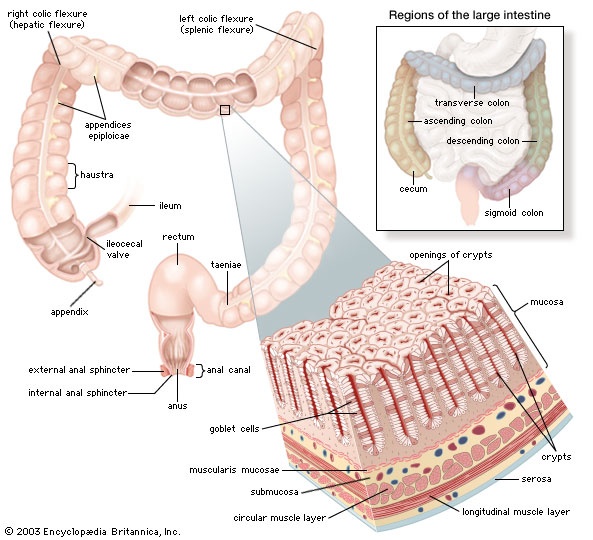large intestine
 posterior section of the intestine, consisting typically of four regions: the cecum, colon, rectum, and anus. The term colon is sometimes used to refer to the entire large intestine.
posterior section of the intestine, consisting typically of four regions: the cecum, colon, rectum, and anus. The term colon is sometimes used to refer to the entire large intestine.The large intestine is wider and shorter than the small intestine (approximately 1.5 metres, or 5 feet, in length as compared with 6.7 to 7.6 metres, or 22 to 25 feet, in length for the small intestine) and has a smooth inner wall. In the proximal, or upper, half of the large intestine, enzymes from the small intestine complete the digestive process, and bacteria produce B vitamins (B12, thiamin, and riboflavin) as well as vitamin K. The primary function of the large intestine, however, is absorption of water and electrolytes from digestive residues (a process that usually takes 24 to 30 hours) and storage of fecal matter until it can be expelled. Churning movements of the large intestine gradually expose digestive residue to the absorbing walls. A progressive and more vigorous type of movement known as the gastrocolic reflex, which occurs only two or three times daily, propels the material toward the anus.
Common afflictions of the large intestine include inflammation, such as colitis (ulcerative colitis); diverticulosis (diverticulum); and abnormal growths, such as benign or malignant tumours.
- Sergey Fyodorovich Platonov
- Sergey Gennadiyevich Nechayev
- Sergey Georgyevich Gorshkov
- Sergey Gordeeva, Yekaterina; and Grinkov
- Sergey Ivanovich Muravyov-Apostol
- Sergey Konstantinovich Krikalyov
- Sergey Mikhaylovich Eisenstein
- Sergey Mikhaylovich Solovyov
- Sergey Mironovich Kirov
- Sergey Nikolayevich Bulgakov
- Sergey Nikolayevich Winogradsky
- Sergey Pavlovich Diaghilev
- Sergey Pavlovich Korolyov
- Sergey Petrovich Novikov
- Sergey Prokofiev
- Sergey Rachmaninoff
- Sergey Semyonovich, Count Uvarov
- Sergey Semyonovich Uvarov, Count
- Sergey Taneyev
- Sergey Timofeyevich Aksakov
- Sergey Vasilyevich Lebedev
- Sergey Vasilyevich Zubatov
- Sergey Vladimirovich Ilyushin
- Sergey Vladimirovich Obraztsov
- Sergey Yosifovich Paradzhanov